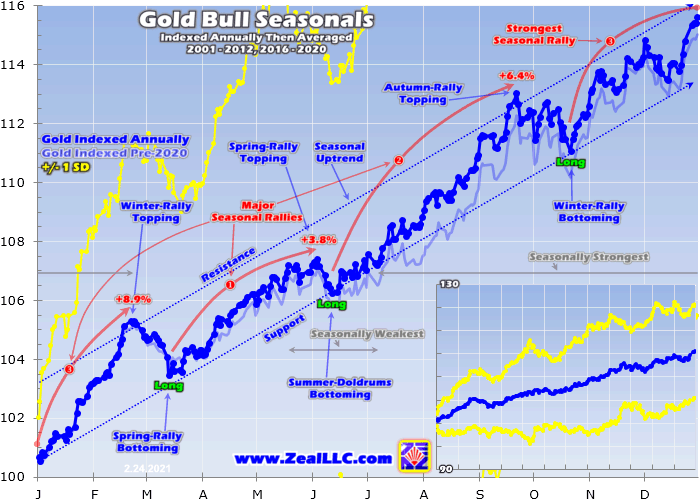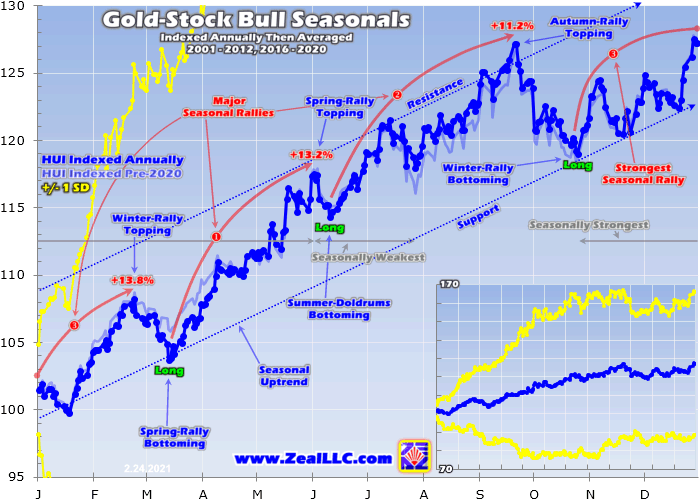Following a necessary correction, the gold miners’ stocks have spent much of recent months bottoming. This healthy basing process is rebalancing sentiment, preparing the way for this sector’s next bull-market upleg. That is looking to coincide with gold stocks’ spring rally, one of their strongest times of the year seasonally. That stiff tailwind blowing behind bullish technicals and fundamentals should make for big gains.
Seasonality is the tendency for prices to exhibit recurring patterns at certain times during the calendar year. While seasonality doesn’t drive price action, it quantifies annually-repeating behavior driven by sentiment, technicals, and fundamentals. We humans are creatures of habit and herd, which naturally colors our trading decisions. The calendar year’s passage affects the timing and intensity of buying and selling.
Gold stocks exhibit strong seasonality because their price action mirrors that of their dominant primary driver, gold. Gold’s seasonality generally isn’t driven by supply fluctuations like grown commodities see, as its mined supply remains relatively steady year-round. Instead gold’s major seasonality is demand-driven, with global investment demand varying considerably depending on the time in the calendar year.
This gold seasonality is fueled by well-known income-cycle and cultural drivers of outsized gold demand from around the world. The seasonal gold year starts in late July as Asian farmers begin reaping their harvests. They plow some of their surplus income into gold. That’s soon followed by the famous Indian wedding season in autumn, with its heavy gold buying for brides’ dowries during marriage-auspicious festivals.
After that comes the Western holiday season, where gold jewelry demand surges for Christmas gifts for wives, girlfriends, daughters, and mothers. Following year-end, Western investment demand balloons after bonuses and tax calculations as investors figure out how much surplus income the prior year generated for investment. Then after that Chinese New Year gold buying flares up heading into February.
Top Australian Brokers
- Pepperstone - Trading education - Read our review
- IC Markets - Experienced and highly regulated - Read our review
- eToro - Social and copy trading platform - Read our review
These understandable cultural factors drive surges of outsized gold demand between late summer and late winter. But interestingly there is one more gold-demand spike in spring. Over the years I’ve seen a variety of theses explaining this mid-March-to-early-June gold rally, but nothing definitive like for the rest of the year’s seasonality. As silly as it sounds, I suspect spring itself is the reason for this demand surge.
Sentiment exceedingly influences investing, which requires optimism for the future. Investors won’t risk deploying their scarce capital unless they believe it will grow. And the glorious expanding sunshine and warming temperatures of spring naturally breed optimism. The vast majority of the world’s investors are far enough into the northern hemisphere that spring has a major psychological impact, buoying their spirits.
While spring’s seasonal impact on gold itself is more muted, the gold stocks tend to blast higher anyway as capital floods in. That optimism fuels gold stocks’ most upside leverage to gold seasonally throughout the calendar year. And this year’s spring rally has real potential to grow considerably larger than usual. Gold stocks’ recent correction short-circuited their winter rally, leaving major catch-up buying for this spring.
Since it is gold’s own demand-driven seasonality that fuels gold stocks’ seasonality, that’s logically the best place to start to understand what’s likely coming. Price action is very different between bull and bear years, and gold remains in a middle-aged bull market. After falling to a 6.1-year secular low in mid-December 2015 as the Fed kicked off its last rate-hike cycle, gold powered 29.9% higher over the next 6.7 months.
Crossing the +20% threshold in March 2016 confirmed a new bull market was underway. Gold corrected after that sharp initial upleg, but normal healthy selling was greatly exacerbated after Trump’s surprise election win. Investors fled gold to chase the taxphoria stock-market surge. Gold’s correction cascaded to serious proportions, hitting -17.3% in mid-December 2016. But that remained shy of a new bear’s -20%.
Gold rebounded sharply from those severe-correction lows, nearly fully recovering by early September 2017. But it failed to break out to new bull-market highs, then and several times after. That left gold’s bull increasingly doubted, until June 2019. Then gold surged to a major decisive breakout confirming its bull remained alive and well! Its total gains grew to 96.2% over 4.6 years by early August 2020, still modest.
Gold’s last mighty bull market ran from April 2001 to August 2011, where it soared 638.2% higher! And while gold consolidated high in 2012, that was technically a bull year too since gold just slid 18.8% at worst from its bull-market peak. Gold didn’t enter formal bear-market territory until April 2013, thanks to the crazy stock-market levitation driven by extreme distortions from the Fed’s QE3 bond monetizations.
So the bull-market years for gold in modern history ran from 2001 to 2012, skipped the intervening bear-market years of 2013 to 2015, then resumed in 2016 to 2021. Thus these are the years most relevant to understanding gold’s typical seasonal performance throughout the calendar year. We’re interested in bull-market seasonality, because gold remains in its latest bull today and bear-market action is quite dissimilar.
Prevailing gold prices varied radically through these modern bull years, running between $257 when gold’s last secular bull was born to early August’s newest record high of $2,062. All those long years with that vast range of gold levels have to first be rendered in like-percentage terms in order to make them perfectly comparable. Only then can they be averaged together to distill out gold’s bull-market seasonality.
That’s accomplished by individually indexing each calendar year’s gold price action to its final close of the preceding year, which is recast at 100. Then all gold price action of the following year is calculated off that common indexed baseline, normalizing all years regardless of price levels. So gold trading at an indexed level of 105 simply means it has rallied 5% from the prior year’s close, while 95 shows it is down 5%.
This chart averages the individually-indexed full-year gold performances in those bull-market years from 2001 to 2012 and 2016 to 2020. 2021 isn’t included yet since it remains a work in progress. This bull-market-seasonality methodology reveals that gold’s spring rally is its last push higher before the summer doldrums arrive. While this is gold’s smallest seasonal rally of the year, the gold stocks greatly leverage it.
2020 proved an amazing year for gold, with this leading alternative investment blasting 25.1% higher! At gold’s early-August all-time-record peak before the recent healthy correction, this metal had soared a huge 35.9% year-to-date. And from mid-March’s stock-panic-driven low to that last upleg topping, gold clocked in with a giant 40.0% gain in just 4.6 months! Any way you slice it, gold enjoyed a phenomenal year.
Such outsized performance really skews the indexed seasonal average, even though 2020 was the 17th year added to this modern-gold-bull span. So I added a new data series in these charts, the light-blue lines showing last year’s seasonality before 2020 entered the mix. Gold’s huge gains during that crazy pandemic year really shifted its seasonal average considerably higher, which certainly doesn’t happen often.
Overall across these last 17 gold-bull calendar years, gold averaged major 15.6% gains. With this kind of growth rate compounded, it takes less than five years for gold prices to double. That’s held true during gold’s current bull too, as gold powered from $1,051 in December 2015 to $2,062 in August 2020. That’s up 1.96x in 4.6 years! Gold’s strong seasonals are the fuel behind gold stocks’ powerful seasonal rallies.
Gold’s own spring rally generally starts in mid-March, after the seasonal pullback following the winter-rally topping in late February. That has pushed gold an average of 1.7% lower in these modern bull-market years. Then from mid-March to early June, gold’s spring rally has averaged relatively-modest 3.8% gains. That makes for gold’s weakest seasonal rally, way behind the winter and autumn rallies’ +8.9% and +6.4%.
In March, April, May, and June, gold has averaged monthly performances of -0.4%, +1.8%, +0.8%, and +0.5%. April is the linchpin of gold’s spring seasonal rally, clocking in at this metal’s 4th-best month on average. But this year’s spring rally has much-greater upside potential than usual. Like many things in the financial markets, seasonality tends to mean revert and overshoot after being forced out of whack.
Normally that massive 8.9% winter rally is gold’s most-powerful seasonal one, running from about late October to late February. But because a healthy bull-market correction overrode that seasonal strength, gold actually fell 5.4% during its latest winter-rally span. Normally when that tops in late February, gold is up 5.3% year-to-date. But this year the yellow metal remained down 5.0% YTD, a serious seasonal disconnect.
So gold’s 2021 spring rally will likely both start earlier and grow bigger than normal, as seasonality mean reverts and overshoots after the recent counter-seasonal correction. Gold needs to see some outsized spring-rally gains to catch up with where it ought to be per seasonal norms. By early June, gold tends to be up 7.4% YTD in seasonal-average terms. Rebounding back to there would boost gold up near $2,038!
If anything remotely close to that happens, this is a super-bullish omen for gold stocks in coming months. Their own spring seasonal rally is directly driven by gold’s. The GDX VanEck Vectors Gold Miners ETF is the leading gold-stock benchmark and trading vehicle. It tends to amplify material gold-price moves by 2x to 3x. So if gold surges about 11% higher to catch up, GDX could see huge 22%-to-33% spring-rally gains!
This next chart applies this same modern-gold-bull-year seasonality methodology to gold stocks. Since GDX was born later in May 2006, its price history is insufficient for longer-term studies. Thus the classic HUI gold-stock index is used instead. GDX and the HUI closely track each other, they are functionally interchangeable containing most of the same large gold stocks. Gold’s gains fuel their major spring rally.
The gold stocks’ spring rally is much stronger than gold’s, averaging hefty 13.2% gains during these same modern-gold-bull years of 2001 to 2012 and 2016 to 2020. Like gold, last year proved very strong for the gold stocks as viewed through the GDX lens. Driven by gold’s massive post-panic upleg, this dominant gold-stock ETF soared 134.1% higher in about that same span! But this sector’s overall performance was weak.
In 2020 GDX merely rallied 23.0%, lagging way behind gold’s 25.1% gain. That’s why these gold-stock seasonals didn’t change as much last year as gold’s did, as evident in the difference between these dark-blue and light-blue lines. Gold stocks’ underperformance last year resulted from the timing of gold uplegs and corrections, leaving the HUI pretty oversold at year-end. On average it has seen 27.2% annual gains.
Like gold, the gold stocks are set up for a much-larger-than-normal mean-reversion-and-overshoot spring rally. Normally this sector surges 13.2% higher between mid-March to early June, really amplifying gold’s own anemic 3.8% spring rally. After decades of study, I still suspect this sector’s strong outperformance results from spring optimism. Speculators and investors are more willing to deploy capital when they feel good.
Broken out into calendar months, in March, April, May, and June the HUI has averaged performances of -0.2%, +3.5%, +4.3%, and +2.4%. April and May together are an exceptionally-strong span for the gold stocks, their fourth- and first-best months of the year seasonally in these modern-gold-bull years! This is actually new, as GDX skyrocketing 40.0% higher in April 2020 out of the stock panic greatly skewed these seasonals.
April’s radically-improved seasonals are very clear on this next chart, which slices gold-stock seasonals into calendar months instead of years. This uses the same methodology discussed above, but applied to months rather than years. Each calendar month is individually indexed to 100 as of the previous month’s final close, then all like-months’ indexes are averaged together. This offers a more-granular perspective.
So seasonally gold stocks have some big months approaching, which are what make their spring rally so strong. Again averaging 13.2%, this year’s has the potential to grow much larger because of gold’s likely mean reversion and overshoot. On average by early June’s spring-rally topping, the HUI has powered up 17.5% year-to-date. To regain that seasonal benchmark would certainly require an outsized surge from here.
As of this week, GDX is down 6.4% YTD due to gold’s lingering bottoming and base-building process. To mean revert back up to +17.5% by early June, GDX would have to soar up to $42.32. That isn’t a stretch absolutely, this leading gold-stock ETF closed at $44.48 in early August as the last parallel uplegs in gold and gold stocks were topping. And getting back on the average seasonal track would require a major rally.
GDX would have to power 25.6% higher from this week’s levels to hit its normal early-summer gains in seasonal terms. With the large gold stocks’ typical 2x-to-3x leverage to major gold moves, those kinds of GDX gains would only need a 9%-to-13% gold spring rally. That is right in line with what is likely if gold itself mean reverts seasonally after its recent correction. The coming months look really bullish for this sector.
Strong spring seasonality is just a minor reason. Seasonals are a secondary driver, unable to override gold stocks’ primary drivers of sentiment, technicals, and fundamentals. Seasonals act more like prevailing winds, either boosting or hindering wherever gold stocks would normally be heading based on gold’s price action. But given this year’s spring-rally setup, these strong seasonals are likely to prove stiff tailwinds.
Because of the recent gold and gold-stock corrections, and subsequent long bottomings and basings, sector psychology is really bearish. Traders are seriously pessimistic on gold stocks, expecting to see them keep spiraling lower with the metal they mine. This is the perfect sentimental backdrop to birth a major new bull-market upleg! Everyone susceptible to being duped into selling low is out, leaving only buyers.
Technically the gold stocks have been really beaten down in recent months, first when their correction initially bottomed in late November at a 24.9% GDX loss. A nice uptrend formed in December, but faded in January as a sharp gold selloff dragged the miners lower. That ultimately culminated in a miserable correction-low retest in late February. Bombed-out oversold technicals birth new bull-market uplegs.
Bearish traders are overlooking fantastic fundamentals for the gold miners. Their Q4’20 earnings season underway is likely to prove their most profitable ever as a sector. The GDX-top-25 gold miners dominating that ETF and the HUI are likely to report unit profits soaring around 65% year-over-year! That will make for their sixth quarter in a row seeing 50%+ YoY growth! The gold miners are thriving with higher gold levels.
With gold stocks deeply out of favor sentimentally and battered technically despite super-strong profits fundamentals, this year’s spring-rally setup is outstandingly-bullish. The gold stocks are poised for major gains in their next upleg, which will likely partially coincide with that spring-rally span. That means this sector’s strong seasonals in April and May will likely act as fierce tailwinds helping catapult gold stocks higher.
Add in that seasonal-mean-reversion dynamic after this sector’s winter rally failed due to that correction, and those 22%-to-33% spring-rally gains in GDX aren’t a stretch at all. If gold stocks’ next upleg really gets humming, powering higher attracting in lots of capital, 50%+ is possible! Last year’s spring rally saw GDX skyrocket 79% higher, although much of that was anomalous rebounding out of a rare stock panic.
With so much upside potential in this contrarian sector, it is important to get deployed in fundamentally-superior gold stocks and silver stocks if you haven’t yet. We’ve been doing that in our newsletters since late November, layering into great gold and silver miners. The current count is up to 19 and 8 new trades in our weekly and monthly. These excellent gold stocks should well outperform GDX during the spring rally.
At Zeal we walk the contrarian walk, buying low when few others are willing before later selling high when few others can. We overcome popular greed and fear by diligently studying market cycles. We trade on time-tested indicators derived from technical, sentimental, and fundamental research. That’s why all 1178 stock trades recommended in our newsletters since 2001 averaged hefty +24.0% annualized realized gains!
The bottom line is gold stocks often experience a strong spring rally seasonally. This is driven by gold’s own seasonality, where outsized investment demand arises at certain times during the calendar year. Gold usually enjoys a solid spring rally likely fueled by the universal optimism this season brings. And since gold drives gold miners’ profitability, their stock prices naturally follow it higher and amplify its gains.
This year’s spring-rally upside potential is much bigger than usual. After a correction steamrolled their winter rally, the gold stocks are way behind seasonally. That positions them for a major mean-reversion surge on very-bullish sentiment, technicals, and fundamentals. The strong spring seasonals should act as a stiff tailwind accelerating gold stocks’ gains in their next upleg. This is one heck of a spring-rally setup!
Published by Adam Hamilton of Zeal LLC Specialising in stock-market speculation and investment from a contrarian perspective. This material has been prepared for general information purposes and must not be construed as investment advice.








